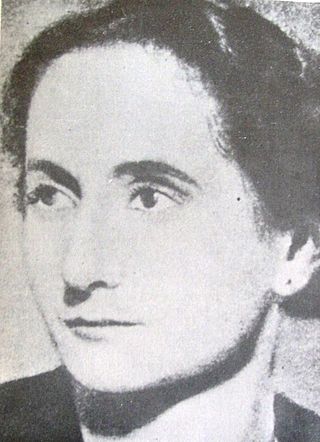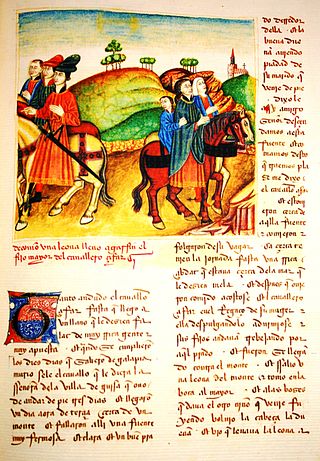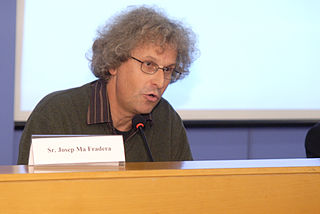Related Research Articles

Juan Ruiz, known as the Archpriest of Hita, was a medieval Castilian poet. He is best known for his ribald, earthy poem, ElLibro de buen amor.

The Book of Good Love, considered to be one of the masterpieces of Spanish poetry, is a pseudo-biographical account of romantic adventures by Juan Ruiz, the Archpriest of Hita, the earliest version of which dates from 1330; the author completed it with revisions and expansions in 1343.

Fernando de Rojas was a Spanish author and dramatist, known for his only surviving work, La Celestina, first published in 1499. It is variously considered "the last work of the Spanish Middle Ages or the first work of the Spanish Renaissance".
Diego de San Pedro was a Castilian writer. Little is known about him, besides what is included in his works. Scholars also rely on what they infer from the context in which he wrote and the many nobles to whom he has been linked.

Alan Deyermond FBA was a British professor of medieval Spanish literature and Hispanist. His obituary called him "the English-speaking world's leading scholar of medieval Hispanic literature". He spent his academic career associated with one University of London college, Westfield College.

The Cancionero de Palacio, or Cancionero Musical de Palacio (CMP), also known as Cancionero de Barbieri, is a Spanish manuscript of Renaissance music. The works in it were compiled during a time span of around 40 years, from the mid-1470s until the beginning of the 16th century, approximately coinciding with the reign of the Catholic Monarchs.

Hispanism is the study of the literature and culture of the Spanish-speaking world, principally that of Spain and Hispanic America. It may also entail studying Spanish language and cultural history in the United States and in other presently or formerly Spanish-speaking countries in Africa, Asia, and the Pacific, such as Equatorial Guinea and the former Spanish East Indies.
The tono humano was one of the main genres of 17th Century Spanish and Portuguese music.

María Rosa Lida de Malkiel, born Maria Rosa Lida, was an Argentine philologist. Notable as an Hispanist medievalist, she came to the United States on a Rockefeller Foundation program of study. Beginning in 1947, Lida de Malkiel lectured for many years in the US, including at Harvard University, the University of California at Berkeley, and Stanford. An advisor to the editorial boards of two professional journals, in the 1950s she was admitted to the Real Academia Española and the Academia Argentina de Letras.

Isabel de Villena was the illegitimate child of Enrique de Villena an unknown noblewoman who rose to become the abbess of the Real Monasterio de la Trinidad of Valencia. As the first major female writer of a work done in the Valencian language, she composed a number of religious treaties. Her most famous work was her Vita Christi. She was also a proto-feminist who tried to change the negative image of women at the time through her writing.

Medieval Spanish literature consists of the corpus of literary works written in Old Spanish between the beginning of the 13th and the end of the 15th century. Traditionally, the first and last works of this period are taken to be respectively the Cantar de mio Cid, an epic poem whose manuscript dates from 1207, and La Celestina (1499), a work commonly described as transitional between the Middle Ages and the Renaissance.
Fidel Villarroel was a Spanish historian, writer, filipinologist, biographer, political commentator, Master Theologian of the Dominican Order, and member of the Order of Isabella the Catholic. A recipient of the Pro Ecclesia et Pontifice, he is the former Archivist, Spanish Department Director, Prefect of Libraries, and professor at the Pontifical and Royal University of Santo Tomas. He had also served as secretary to the Apostolic Nunciature for 32 years(1959–1991), and is currently an academic director of the prestigious Academia Filipina de la Lengua Española, the local branch of the renowned Real Academia Española based in Madrid, Spain, and part of the Asociación de Academias de la Lengua Española.
Noël Ritter Valis is a writer, scholar and translator. She is a Professor of Spanish at Yale University.
The Cancionero de la Sablonara is a Spanish manuscript containing polyphonic canciones from Spain and Portugal, composed in the first quarter of the 17th century.
The Cancionero de Segovia or Cancionero Musical de Segovia (CMS), also known as Cancionero of the Segovia Cathedral, is a manuscript containing Renaissance music from the end of the 15th century and beginning of the 16th century. It contains a wide repertoire of works by mainly Spanish, French and Franco-Flemish composers. It is kept at the Segovia Cathedral Archives.
Eric Woodfin Naylor was an American Hispanist, scholar and educator.

Josep Maria Fradera Barceló is a Spanish historian, professor of Contemporary History at the Pompeu Fabra University. Specialised in the colonial system of the late Spanish Empire, he has also studied the history of Catalonia.

The Monument to Isabella the Catholic is an instance of public art located in Madrid, Spain. A work by Manuel Oms, the monument is a sculptural bronze ensemble consisting of an equestrian statue of Isabella of Castile, accompanied by Pedro González de Mendoza and Gonzalo Fernández de Córdoba.
Julio Aróstegui Sánchez (1939–2013) was a Spanish historian. Professor at the Complutense University of Madrid (UCM), some of his research lines included the study of political violence in Modern Spanish history, Carlism, the Spanish Transition, the Spanish Civil War, the history of the workers' movement and collective memory. His scholar production also intertwined with the theoretical problems of history and the methodology of research.
References
- ↑ Negotiating the glass ceiling: careers of senior women in the academic world David, Miriam E. and Woodward, Diana. Routledge, 1998 ISBN 0-7507-0837-9 ISBN 978-0-7507-0837-1 at Google Books
- ↑ "University of Liverpool - School of Cultures, Languages and Area Studies". Archived from the original on 15 February 2020. Retrieved 1 November 2009.
- ↑ Association of Hispanists of Great Britain and Ireland Accessed 2009-10-31
- ↑ Real Academia Española Archived July 9, 2012, at the Wayback Machine (in Spanish)
- ↑ Macleod, Maxwell. "Obituary: Adventurer who rebuilt ancient craft to retrace epic, historic routes". The Herald . No. 23 February 2021. Glasgow. p. 20. Archived from the original on 21 January 2022.